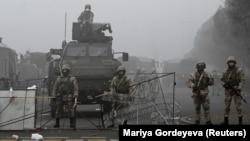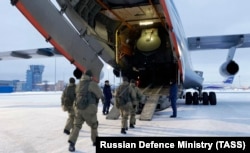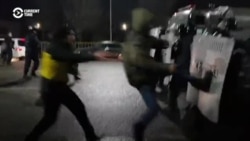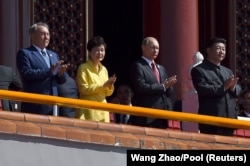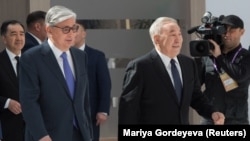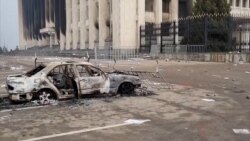The first flights carrying Russian troops to Kazakhstan to help the embattled government quell an unprecedented wave of unrest and armed clashes arrived in Almaty, the Central Asian country’s largest city, early in the morning on January 6.
They are part of a “peacekeeping” force sent via the Collective Security Treaty Organization (CSTO) -- a Moscow-led military bloc of which Kazakhstan is a member -- and come at the invitation of Kazakh President Qasym-Zhomart Toqaev, who requested the troops after a televised address on January 5 in which he called the demonstrators “a band of international terrorists” that he claimed were trained abroad and were “undermining the integrity of the state.”
The arrival of Russian and Belarusian, Armenian, Tajik, and Kyrgyz troops under the guise of the CSTO marks a new chapter in a quickly evolving crisis that has threatened the authoritarian government in Kazakhstan and left its autocratic neighbors -- from Uzbekistan to Belarus to Russia -- watching anxiously as Central Asia’s richest country has been pushed to the brink.
“We see an increased resolve from Russia to come support their clients or loyal allies,” Alexander Gabuev, a senior fellow at the Moscow Carnegie Center, told RFE/RL. “If successful, this will reinforce the role of Russia as the main security guarantor in the region.”
Initially sparked by a peaceful outcry over a fuel-price rise on January 2, the protests quickly spread across the oil-rich country of 19 million and swelled to take in wider discontent with Toqaev and Nursultan Nazarbaev, his predecessor who ruled for nearly 30 years and kept significant powers after stepping down in 2019.
Anger over rising prices, dimming economic prospects, entrenched corruption, and autocratic rule have fueled the uprising and helped spark unrest that has seen government buildings, TV stations, airports, and businesses stormed by thousands of protesters.
As the Kazakh government now turns to external help in the form of the CSTO and deploys its own troops to suppress protesters as part of an “anti-terrorist operation,” events in the country are set to reverberate across the region, where they’re seen as both a warning and a test for other like-minded regimes.
That holds particularly true for Russia, where President Vladimir Putin -- informed by previous popular movements against Kremlin-aligned governments in Ukraine in 2014 and Belarus in 2020 -- has backed an unprecedented mission to support a beleaguered partner.
“I don’t think that [Moscow] can afford the departure of Toqaev and there is a determination on display to use any tool necessary to prop up the regime,” said Gabuev.
Regional Reaction
The decision to send CSTO troops into Kazakhstan was announced by Armenian Prime Minister Nikol Pashinian, the current chairman of the organization, who said in a statement that the forces would be stationed in the country only “for a limited time period” until order could be restored and would primarily focus on protecting infrastructure. Moscow also sent paratroopers, the organization said.
The move marks the first time since the alliance was founded in 1999 that it has agreed to deploy military forces to support a member.
The CSTO, which consists of Russia, Belarus, Armenia, Kazakhstan, Kyrgyzstan, and Tajikistan, has refused requests for troops in the past, including during ethnic unrest in Kyrgyzstan in 2010 and in Armenia in 2021 amid an armed conflict with Azerbaijan.
There is no indication that the crisis in Kazakhstan has any external origin, but the purported terrorist threat that Kazakh authorities have blamed for the violence appears to have been enough justification for the CSTO to intervene.
“This shows the special role that Kazakhstan plays in Russian foreign policy,” said Gabuev.
The announcement of the CSTO deployment came just hours after Dmitry Peskov, Putin’s spokesman, said it was important that no foreign countries interfered in Kazakhstan.
Toqaev had also spoken earlier with Belarusian leader Alyaksandr Lukashenka, who brutally crushed a popular pro-democracy movement in 2020 and has since relied heavily on Russian economic and political support to stay in power.
The Uzbek Foreign Ministry has issued a statement supporting the Kazakh government, with Tashkent calling for the crisis to be handled “independently” and “without outside interference.”
The protests are also a source of anxiety for China, which has used Kazakhstan as the launching pad for its Belt and Road Initiative and invested billions in the country over the last decade.
Chinese Foreign Ministry spokesman Wang Wenbin said on January 6 that events in Kazakhstan were an internal affair and that Beijing hopes the situation will stabilize soon.
Hu Xijin, an influential Chinese nationalist commentator who recently stepped down as editor in chief of the state-run tabloid Global Times, wrote on social media that the unrest in Kazakhstan was similar to a “color revolution,” in reference to the wave of protests that removed pro-Kremlin leaders from Georgia in 2003 and Ukraine in 2005. Hu also added that China and Russia would work together to resolve the situation and resist alleged outside interference.
“Russia and China won't allow the [United States] and the West to push Kazakhstan into long-term turbulence,” Hu tweeted on January 6.
A New Era
Kazakhstan’s quick descent into chaos in a matter of days is likely to send shock waves across the wider region well into the future.
Toqaev’s government tried at first to placate the demonstrators, restoring the subsidized prices on various types of fuel and removing Nazarbaev -- who had become a primary target in the protests -- as head of the country’s influential National Security Council. Toqaev also forced the government to resign and appointed new figures to high-ranking roles, even replacing a nephew of Nazarbaev in the process.
But such moves have done little to calm the wider economic and political resentment toward the government that had built up over decades, leaving the Kazakh authorities with few untested responses beyond the use of force and support from the CSTO.
Three decades of authoritarian rule have not left much to build on in the Central Asian country, with Nazarbaev and his Nur Otan party dominating the political landscape and his allies and relatives having a stranglehold on the media.
The government has tried in the past to calm widespread discontent with limited reforms and shifting government roles.
In 2019, Nazarbaev stepped aside to be formally recognized as the “leader of the nation,” allowing him to hold tremendous formal and informal power.
He tapped Toqaev to be his successor and the longtime Nazarbaev loyalist's first order of business as president was to rename the country’s capital from Astana to Nur-Sultan in honor of his predecessor.
“Kazakhstan has shown that you can have leadership change without really having regime change, and they can do it again,” Luca Anceschi, a professor of Eurasian Studies at the University of Glasgow, told RFE/RL.
This has left Kazakhstan with a relatively limited political scene and no high-profile opposition figures, raising questions about the future direction of the current protests and how they could unite to enact meaningful changes.
“The protests don’t really have any specific leader and there isn’t a consolidated opposition, which means that the regime could still recuperate,” Erica Marat, an associate professor at the National Defense University in Washington, told RFE/RL.
The situation on the ground continues to change quickly and getting a clear picture of what is happening in Kazakhstan is proving difficult amid a nationwide Internet blackout and travel restrictions as security forces carry out “anti-terrorist” operations in Almaty, the heart of the protests.
In the meantime, regional governments will continue to watch events closely as the Kazakh government looks to hold onto power.
“CSTO contingents won’t solve any of the domestic issues [or] alleviate economic and political grievances,” said Marat. “They will deepen authoritarianism in Kazakhstan and may cause an even larger escalation of protests.




